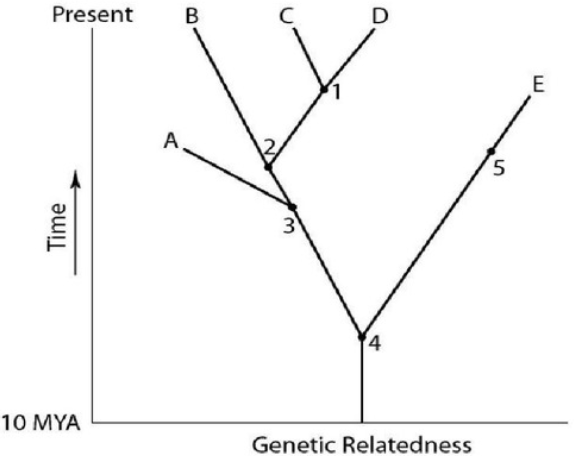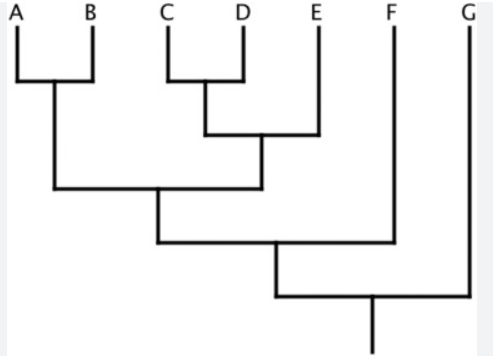1. Define: adaptation
A heritable trait that allows an organism to better survive and reproduce in a certain environment
2. True or false: In order for evolution to occur, genetic variation must be present in the population
True. Must be able to recombine and form new unique organisms for a chance to change. cannot change a species if every single individual is exactly the same
3. What does it mean if a population is "better adapted to survive"
It has traits that increase it's chances to survive and reproduce
4. What did Darwin study in the Galapagos Islands?
the beaks of finches
5. What is a human cause of extinction?
Pollution, habitat destruction/building construction, introducing new predators, urbanization, over-harvesting/fishing
6. Define: evolution
The gradual change in a feature/behavior/characteristic of an entire species over time
All existing life forms have evolved from earlier forms
7. Artificial or Natural Selection?
Wolves with thick fur fair better in the cold winters. The wolf population becomes increasingly thick-furred the next spring.
Natural selection. The wolves with thick fur stayed warmer than thin-furred wolves. More thin-furred wolves would have died than thick-furred. More thick-furred wolves reproducing
8. What is the thing that "selects" for or against the traits of an organism?
Who decides what traits are good vs bad?
the environment!
9. Where was Charles Darwin from?
England
10. "______________" with another native species for limited food/resources can lead to the extinction of a species.
Competition
11. A change in the DNA of a gene that may lead to a different trait is called a "________"
mutation
12. Artificial or natural selection?
Breeding dogs to get friendlier, faster or more useful versions of the purebred
Artificial. Humans determine what's "better," and humans must choose to/follow through with breeding the dogs
13. Scientists are observing a population of insects in the same climate over a long period of time. Which piece of evidence would NOT indicate that evolution has occurred?
A. The distribution of traits in the population has shifted
B. The phenotypes of the traits in the population remain the same
C. The population is better adapted to survive in its environment
D. The allele frequency of a particular gene has increased
B. If nothing ever looks different, it probably isn't changing
14. How did Darwin's Finches demonstrate the process of natural selection?
Birds with beaks fit to crack/eat the seeds on the island survived to reproduce. Different areas/times = different seeds = different types of beaks
15. Which scenario describes an example of extinction?
A. Water pollution kills off all the fish that live in a small pond
B. The cutting down of a tree forces a bird to build a new nest in another tree
C. Every individual of a wolf is killed by hunters or a lack of food
D. A population of deer must move to a new forest after its original forest was destroyed by fire.
C. Extinction = wiping out entire species from everywhere
16. "___________" is the process where organisms with traits better suited to their environment better survive and reproduce.
Natural Selection
17. A bunny lives in a moist forest climate. Overtime, it gets colder and snowier. Which adaptation would most likely help the species survive as the environment changes?
A. Living above ground
B. Being able to eat plants that survived the changing climate
C. Having light hair and large ears
D. Being able to only eat one type of berry
B. Bunny needs some sort of food source. Even if it doesn't get eaten due to its light fur and good hearing, it can't do much without food. Bunnies are herbivores. If they couldn't eat any of the plants in the cold environment, they might be in danger
18. What are the three types of adaptations?
Behavioral (migration, spider spinning a web)
Structural (beak size, fur thickness)
Physiological/Bodily (internal functions like digestion or production of venom)
19. Darwin's theory of evolution explains all of the following except how:
A. species can become extinct
B. species descend from ancestors
C. inherited traits are passed from parent to youth
D. evolution takes place in the natural world
C
20. Which species is extinct?

A. Doesn't make it to the top of the chart with other present species.
21. If an allele of a certain trait (say the trait is fur, the allele is brown) helps an organism survive in it's environment. How would the frequency of the allele change over time?
Increase
frquency = how often something occurs, here it would be how many organisms have the brown fur as opposed to another color
More brown furred organisms would survive to reproduce to make more brown furred-organisms
22. What is the difference between an adaptation and evolution?
Adaptations describe variations amongst individuals in a population. One animal has an adaptation. A variation in an organisms genetic code that gives it slightly different features than others.
Evolution describes a change in an entire population over time. The whole population becomes more/less of something. The individuals with helpful adaptations will begin to dominate populations as the weaker individuals die out. Takes a long time
23. Are all mutations bad?
No, mutations are just random changes in DNA that cause variation (alleles). Some can be harmful or damaging, while others only slightly modify or advantageously modify a gene.
24. Does Darwin's Theory of Natural Selection mean the same thing as evolution?
No. Evolution describes a broad process (an umbrella term) for how a species changes over time. Natural selection is one of the methods to change overtime through genetic variation. Natural selection helps describe why evolution exists.
25. Which species would be most similar to D

C, from same most recent common ancestor